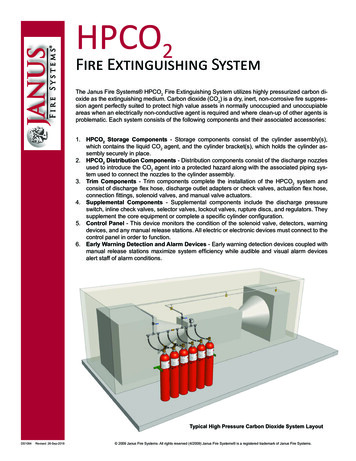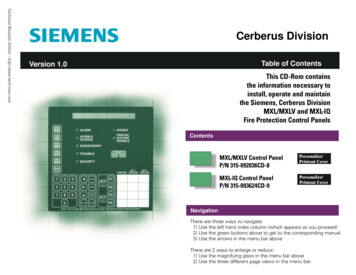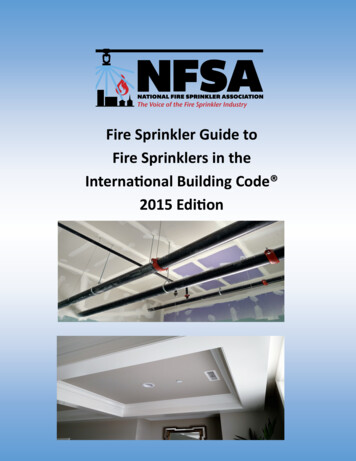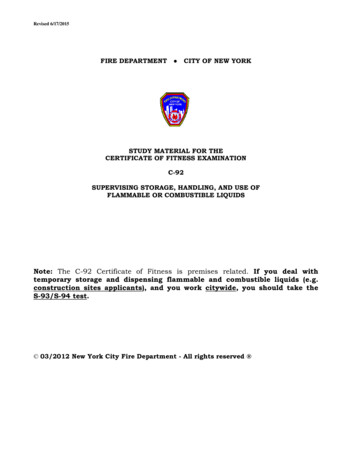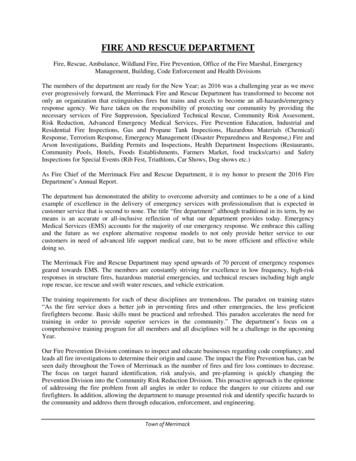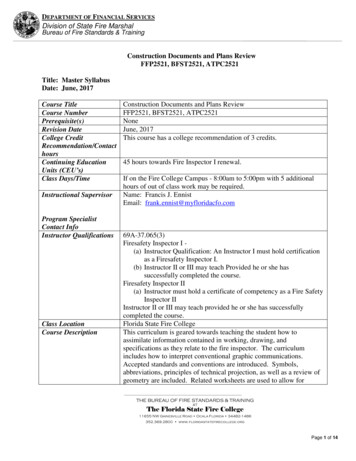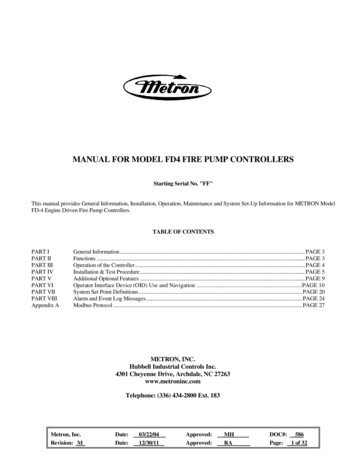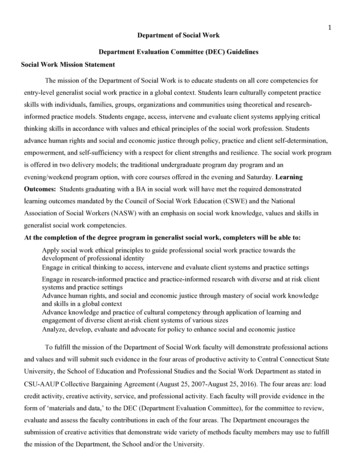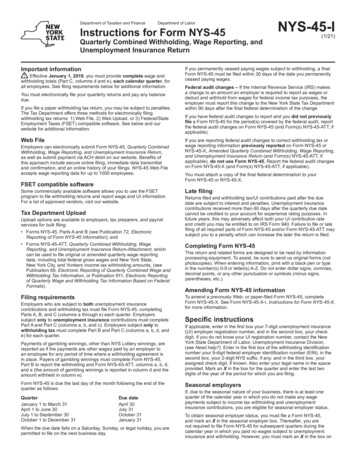
Transcription
Chaplains ManualFire Department FuneralsFederation of Fire Chaplains185 County Road 1602Clifton, Texas 76634-4508(254) 622-85142/2004
Chaplains ManualAcknowledgementThe Federation of Fire Chaplains would like to acknowledge its partnership with the NationalFallen Firefighters Foundation. Through this partnership, both organizations are better able tomeet the needs of the fire service family.The Foundation offers extensive grief-related resources to the survivors of firefighters killed andseriously injured in the line of duty. Out of its work with the survivors, came the suggestion fordevelopment of Taking Care of Our Own, a training program to help senior fire officers betterprepare for the loss of a firefighter in the line of duty. A key resource for the program is thisChaplains Manual.The Federation provides this manual to assist fire departments through the worst of times. Inaddition, the Federation offers comprehensive training and resources for fire service chaplainswho play such a vital role in helping departments and the survivors in local communities.The Federation would also like to thank the National Fallen Firefighters Foundation for itsassistance in the printing of this valuable resource.iFederation of Fire Chaplains
Chaplains ManualiiFederation of Fire Chaplains
Chaplains ManualTable of ContentsIntroduction1Section 1Section 2Section 3Section 4Section 5Section 6Section 7General GuidelinesPre-Incident PlanningFuneral TypesFuneral or Memorial Service Planning ConsiderationsKey Assignments for Fire Department FuneralsOther ConsiderationsCeremonies35911171921Appendix 1Appendix 2Appendix 3Appendix 4Appendix 5Appendix 6Appendix 7Appendix 8Appendix 9Appendix 10Appendix 11Employee Emergency Contact InformationSuggestions on Preparing a Fire Service EulogySuggested Funeral Home FormationsSuggested Church FormationsSuggested Final Committal Service FormationsPallbearers’ Locations When MarchingMilitary StandardsTraditional Method for Folding the Flag of the United StatesSuggested “Last Alarm” CeremonySample Order of EventsHandling Dignitaries at Fire Department Funerals2729333537394143454751Responsibility SheetsSurvivor Action OfficerFamily Liaison OfficerFuneral OfficerProcession OfficerService OfficerFinal Committal Officer555963656971iiiFederation of Fire Chaplains
Chaplains ManualivFederation of Fire Chaplains
Chaplains ManualIntroductionNo one likes to consider the prospect of arranging and conducting a funeral or memorial servicefor someone who has touched our lives. As fire chaplains, however, we serve a group of braveand dedicated men and women who continually place themselves in harm’s way. Far too oftenthey make the ultimate sacrifice. They give their lives as they strive to protect the lives andproperty of the communities they serve.When the unthinkable happens, it is up to the chaplain to do all he or she can to ensure that thefallen firefighter receives a tribute befitting the sacrifice. In this regard, no effort is too large, andno detail is too small. It is truly a time for “all things to be done decently and in order.” Thepurpose of this manual is to provide basic information that a chaplain can use to help thedepartment through a very trying time. It should also be part of a Standard Operating Procedureon how to handle all aspects of the death of a firefighter.This manual is not intended to be all-inclusive in content or to present only one approach.Instead, it provides information covering a broad spectrum of subjects. This information comesfrom many sources and from what departments and families of fallen firefighters recommended.From this information, the chaplain may choose what best fits a particular situation and adapt itas necessary.There are two keys to conducting a proper fire department funeral: showing honor to the fallenfirefighter, and caring for those left behind. If the chaplain accomplishes these two things, thechaplain has done his or her job well.1Federation of Fire Chaplains
Chaplains Manual2Federation of Fire Chaplains
Chaplains ManualSection 1:1.1GENERAL GUIDELINESWhen a member of the Fire, Emergency Medical or Rescue Services dies in theline of duty, several considerations are crucial for those dealing with the tragedy.These include:a.Identifying and meeting the needs of the surviving familyb.Ensuring that the needs and wishes of the family always come before theneeds and wishes of the departmentc.Providing ongoing emotional and spiritual support for the next of kind.Using good organization, coordination and communicatione.Maintaining flexibilityf.Monitoring constantly not to overload any individuals1.2The primary goal of the fire department should be to work with the family, thefuneral director and others involved to ensure that the fallen firefighter receives afitting tribute. At all times the fire department must carry out the wishes anddesires of the surviving family regarding the funeral ceremonies.1.3The fire department’s responsibilities are not the same as those of the funeraldirector. Fire department personnel should work with the funeral director in thebest interest of the firefighter's family.3Federation of Fire Chaplains
Chaplains Manual4Federation of Fire Chaplains
Chaplains ManualSection 2:PRE-INCIDENT PLANNINGPre-planning is essential to ensure the department meets the needs of the family andcoworkers.2.1Fire Department Chaplain - The department should maintain an active chaplaincyprogram. The chaplain should be contacted immediately whenever the death of afire department member is imminent or confirmed, regardless of thecircumstances involved. The chaplain's services will be available to the survivingfamily before, during and after the funeral.2.2Personnel Information – The department should maintain an EmergencyEmployee Contact Information Record on all department personnel. Thedepartment will use it to assist in the treatment of personnel following seriousinjury, and in the notification of next of kin following a serious injury or line-ofduty death. The form will contain the following information:a.Complete name of the department memberb.Name and address of next of kin with specific directions to the address asneededc.Names of parents and children/dependents, including those who may notlive with the firefighterd.The firefighter’s religion and church affiliation and membershipAppendix 1 contains a sample Emergency Employee Contact Information formcreated by the National Fallen Firefighters Foundation.2.3Photographs - The department should arrange for individual photographs of alldepartment personnel and should maintain current photographs in departmentpersonnel files. The photos may be needed for immediate identification after anincident. After a line-of-duty death, there will be requests for photos from themedia and other sources.2.4Local Support Agencies - The department should periodically contact local publicsafety agencies to maintain a current resource list of:a.Honor Guard and Color Guardb.Bands, buglers, pipersc.Firing partiesd.Bells for "Last Alarm" service5Federation of Fire Chaplains
Chaplains Manuale.Vocal and instrumental performers2.5Funeral Directors – The department should contact and provide the local funeraldirectors a copy of the department’s funeral procedures. This will allow them tounderstand local protocols before a line-of-duty death occurs.2.6Ceremonial Clothing and Equipment - The department should have the followingavailable for use during fire department funerals:2.7a.Badge and name tag presentation frameb.An extra badge for each rank in the department as well as the name of asource for obtaining a duplicate name tag on an emergency basisc.Presentation flags (U.S., state, municipality, fire department)d.White gloves in sufficient numbers for the Honor Guard and eightpallbearersKey Positions - The department should maintain and annually update a list ofpersonnel selected to serve in the following key positions:a.Survivor Action Officerb.Notification Officerc.Family Liaison Officerd.Hospital Liaison Officere.Funeral or Memorial Service Officerf.Procession Officerg.Service Officerh.Final Committal OfficerPersonnel selected to serve should receive a manual and training on theresponsibilities of key positions. The manual should contain copies of firedepartment procedures relating to funerals or memorial services.2.8Honor Guard and Color Guard - The department should encourage personnel toparticipate in a department Honor Guard and Color Guard that will functionduring fire department funerals and at other appropriate times. If possible, the6Federation of Fire Chaplains
Chaplains Manualdepartment should provide the following:a.Class A ("dress") uniforms with cap, white shirt, black tie, and whiteascot, for all membersb.White gloves for all membersc.White shoulder braiding for all membersd.Patent leather low-quarter shoes for all memberse.Parade flags (U.S., state, municipality and fire department) with holdersf.Two display axes with chrome or brass headsCareer departments should establish an official leave policy to allow members toprovide these services.7Federation of Fire Chaplains
Chaplains Manual8Federation of Fire Chaplains
Chaplains ManualSection 3:FUNERAL TYPESThe death of a firefighter may occur under a variety of circumstances. Based on thecircumstances, the department should provide appropriate services from the planning ofthe funeral through the survivor follow-up process. To ensure all fallen firefighters arehonored in a consistent manner, the department should adopt a policy on the types ofservices it will provide. The following policy is an example of what one state hasadopted.3.13.2Definitionsa.Line-of-duty: The death must be the result of a traumatic injury sufferedin the line of duty.b.Job-related traumatic injury: A blow to the body by an outside force, e.g.,crushing injuries suffered in a building collapse, apparatus accident or fall.Burns, smoke inhalation and such climactic injuries as heatstroke orfrostbite are considered traumatic injuries.c.Job-related non-traumatic injury: A non-traumatic injury that is stronglybelieved or has been proven to be attributable to the job. Examples arestress, heart attacks, strokes, diseases and mental illness (suicide).d.Active member: A full-time or volunteer member of a fire or emergencymedical service agency serving in an active capacity.e.Inactive member: A retired or former member of a fire or emergencymedical service agency.f.Affiliate member: An individual who has served in some capacity with thedepartment, such as a commissioner, trustee, dispatcher, etc.g.Non-job-related death: Deaths, natural and traumatic, that are not relatedto fire or emergency medical service duty.Types of Servicesa.Level One: A line-of-duty or job-related death. This may include aninactive member whose death has stemmed from an injury sustainedduring active duty.b.Level Two: A non-job-related death of an active member.c.Level Three: A non-job-related death of an inactive or affiliate member.9Federation of Fire Chaplains
Chaplains Manual3.3SUGGESTED FUNERAL SERVICE OPTIONSLevel OneLevel TwoAmerican FlagBadge shroudsBagpipersBell serviceBuglerColor GuardCrossed laddersEulogyFire engine caissonFire service flagFlower unitHonor GuardHonor detailPallbearers, activeStation buntingVehicle buntingWalkthrough.10Federation of Fire ChaplainsLevel ThreeAmerican FlagBadge shroudsAmerican FlagBadge shroudsBell serviceBell serviceEulogyHearseFire service flagFlower unitHonor GuardHonor detailPallbearers, honoraryStation buntingVehicle buntingWalkthroughHearseFire service flagHonor GuardPallbearers, honoraryStation buntingWalkthrough
Chaplains ManualSection 4:FUNERAL OR MEMORIAL SERVICE PLANNING CONSIDERATIONSThere are many ways for the department to offer help for the funeral or memorial service.Some families will welcome all offers of help, while others may choose to have nodepartmental involvement. The family must always be allowed to make that choice.4.14.2Honor Guard – If the family requests an Honor Guard, the Funeral Officer shouldcoordinate with Honor Guard personnel to schedule Honor Guard activitiesaccording to the family’s and funeral director's wishes. The following basic rulesapply to these activities:a.Two Honor Guard members should be posted at the casket. Duringviewing hours, they should be posted at the head and at the foot.b.There should be a minimum of four Honor Guard members for each set ofviewing hours.c.Honor Guard members should rotate at 15-minute intervals. Relief guardsshould march up together. Posted guards should come to attention andsmartly make the transfer and then march off together.d.Posted Honor Guard should assume the position of parade rest.e.American and department flags (or a state flag, if there is no departmentalflag) should be posted at the casket.f.Honor Guard members should wear Class A uniform, if available, withwhite gloves. They should use black mourning bands over uniformbadges. If a department does not have Class A uniforms, dress uniformsare an acceptable option.Pallbearers - Should the family choose to use department members as pallbearers,it is the Family Liaison Officer's responsibility to ask which firefighters thefamily would like to use. There should be between six and eight pallbearers.They should wear Class A uniforms with hats and white gloves.a.Due to their specific responsibilities, pallbearers are exempt fromfollowing the majority of orders given to the remainder of the formation.b.The Funeral Officer, assisted by the Funeral Director, should giveinstructions on removing, handling, and transporting the casket.If a fire engine serves as a caisson, pallbearers should hold a practicesession the day before the funeral. If this is not possible, pallbearersshould report to the funeral home several hours before the beginning of theservice for a protocol briefing and practice.11Federation of Fire Chaplains
01.10.2003 · Appendix 3 Suggested Funeral Home Formations 33 Appendix 4 Suggested Church Formations 35 Appendix 5 Suggested Final Committal Service Formations 37 Appendix 6 Pallbearers’ Locations When Marching 39 Appendix 7 Military Standards 41 Appendix 8 Traditional Method for Folding the Flag of the United States 43 Appendix 9 Suggested “Last Alarm” Ceremony 45 Appendix 10
